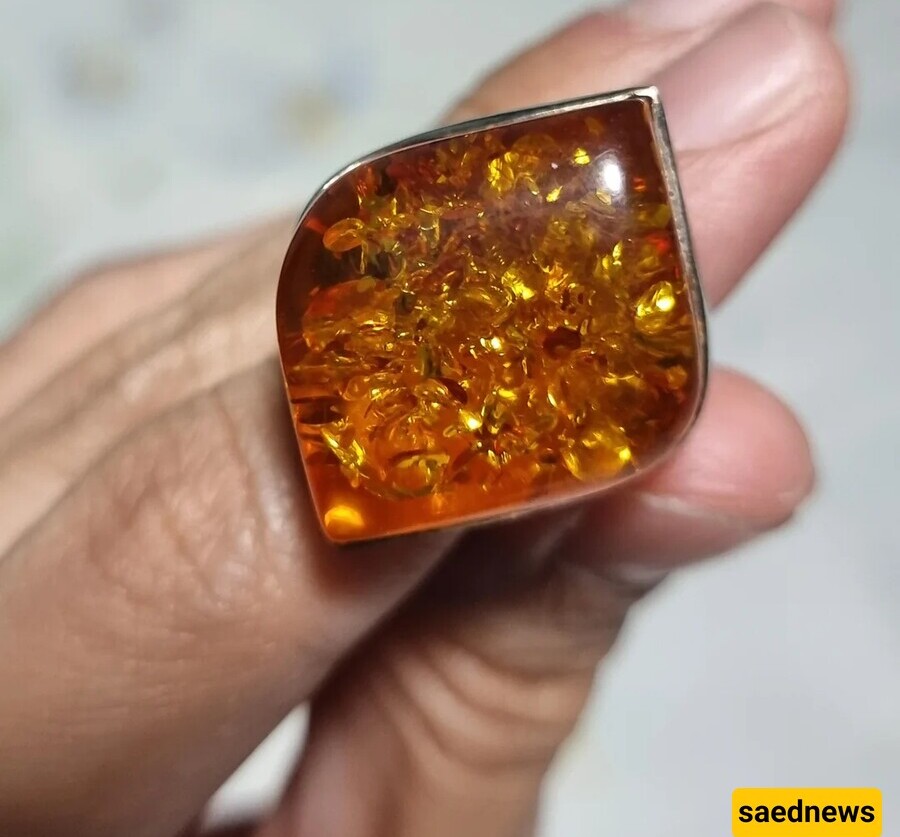Amber stone is actually a fossilized resin from a type of tree that has hardened over many years. It is said that this stone also has some health benefits. The natural color of amber is yellow and orange, but what is referred to as black amber is actually jet, which has become known by this name.

Amber is not actually a stone, but a type of fossilized resin. However, since the beautiful jewelry made from it resembles precious stones, it is referred to as a gemstone. Amber is very popular due to its amazing metaphysical properties that are beneficial for protecting the soul. This stone reduces stress by alleviating fears and phobias and is a warm and lovely stone that you can use. Amber is a powerful healer, providing a sense of well-being to those who carry it. This stone helps balance emotions, cleanse the mind, and release negative energy. In this article, we will discuss some of the properties attributed to this stone and give an overview of different types of amber.
Amber Properties:
Metaphysical Effects: Amber is generally formed from fossilized tree resin, typically from pine trees, which is yellowish-brown and has been around for approximately 50 million years. It has been recognized as a gemstone since ancient times and is used in jewelry. The finest and most beautiful amber can be found in countries like Poland, the Baltic Sea, the Ural and Siberian regions, and the Dominican Republic. Ancient peoples discovered these gems and used them in the creation of the earliest and most popular decorative items. Collectors, scientists, and gem researchers value amber for containing the remains of past plants and animals.

Effects on the Body: Amber is a versatile and powerful healing stone with remarkable effects on allergies, eczema, and skin rashes. It can also heal allergies caused by animals, pollen, hay fever, etc. This stone alleviates tooth pain in children, dental root discomfort in adults, and other oral discomforts. It reduces joint inflammation, chronic diseases, rheumatism, and back pain. Additionally, amber is helpful for throat pain, colds, fever, eye and ear pain, and respiratory tract infections like bronchitis, coughs, and asthma. Amber boosts metabolism in the body and supports the liver and thyroid function. Wounds and inflammation in areas such as the knees, lower legs, pelvis, and muscles can also be treated with amber.
Effects on the Mind and Spirit: Amber encourages us to heal diseases and maintain balance in the body. It enhances willpower and supports us in preventing illness before it becomes serious. Amber, also known as the "calming stone," is a crystal that soothes nerves. It dispels negative energy from individuals and encourages them not to take life too seriously. It is also calming during post-surgery recovery, helping to ease emotions and excitability.
Healing Effects of Amber:
It helps to manage excess energy and removes negative energy.
It attracts positive energy and promotes calmness.
Therapeutic Properties of Amber:
Treats arthritis
Reduces joint inflammation
Heals asthma
Treats ulcers
Reduces allergies
Heals eczema
Treats bronchitis
Reduces swelling in the feet
Treats spine disorders
Heals herpes
Fights the evil eye
Treats skin itching
Alleviates facial pain
Treats boils and abscesses
Stimulates growth
Heals wounds
Treats shingles
Corrects spinal misalignment
Reduces coughing
Works as a forehead stone and protector
Helps with sciatica
Treats whooping cough
Reduces arteriosclerosis
Treats dandruff
Supports the liver
Treats infections
Strengthens muscles
Supports ligaments



How to Identify Real Amber: Amber has specific characteristics that can help you determine its authenticity:
Amber has a specific weight, with each square centimeter weighing 1.08 grams, which allows it to float on saltwater.
Amber is flammable.
Amber develops an electric charge when rubbed, attracting small particles like paper or fabric.
When rubbed, amber releases the scent of resin.

How to Care for Amber: Amber is softer and more brittle compared to other gemstones, so it requires extra care. Generally, you should avoid contact with chemicals such as hairspray, acids, and perfumes. Contact with soap and other detergents may leave a white residue on amber. Lastly, avoid exposing amber to high-temperature water or heat.
Types of Amber:
Natural Amber: This amber is extracted naturally. The most famous natural amber is Baltic amber, which comes from the forests of Northern Europe in the Baltic region.
Pressed Amber: This amber is made by melting and then pressing small pieces of natural amber.
Note: The "black amber" commonly used for bead necklaces is actually jet (also known as "Jet" in English) and is mistakenly referred to as black amber because it can generate a similar electric charge when rubbed.
Major Amber Mines Around the World: Countries like Italy, the Dominican Republic, Romania, Burma, China, Canada, Mexico, Japan, Russia, and the United States have amber mines. The largest amber mine in the world is located in western Kaliningrad, Russia, at a depth of 30 meters below sand and gravel.
Amber Color: The color known as amber, pronounced "Amber" in English, is a hue between orange and yellow. It has widespread use in lighting industries, and is sometimes used alongside primary lights (blue, green, red) to create a spectrum of color.

